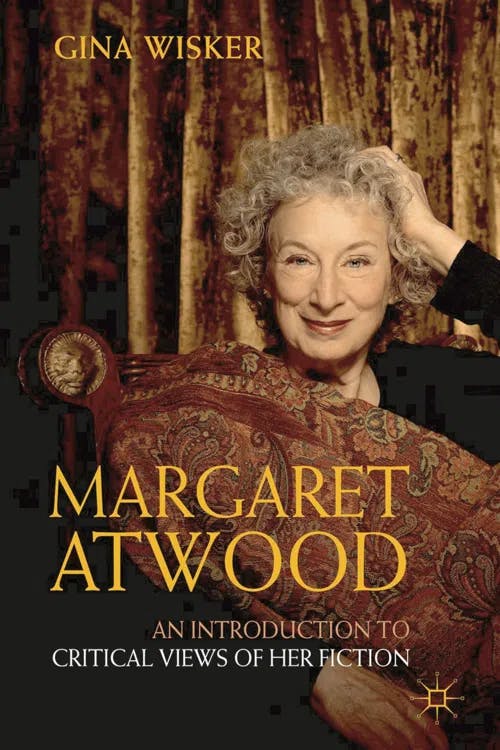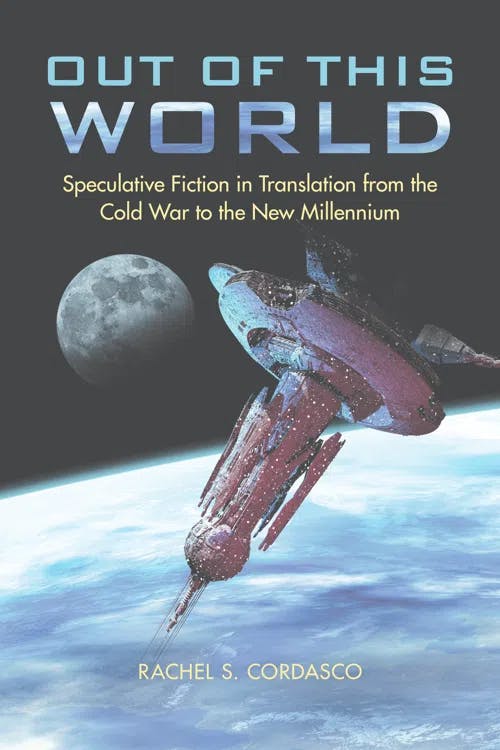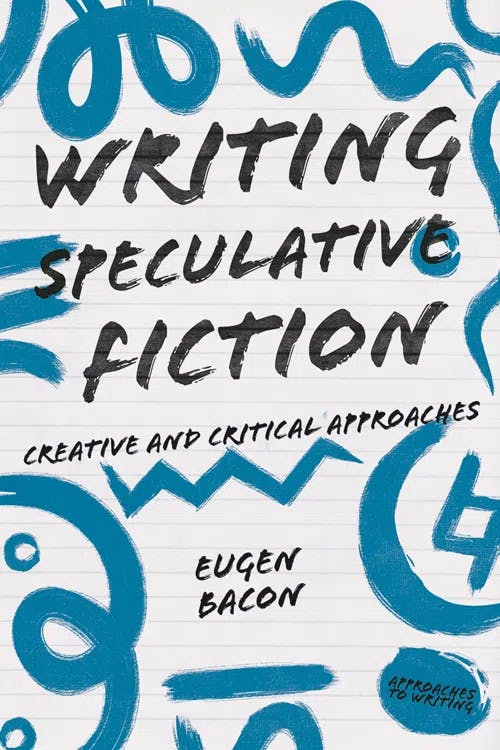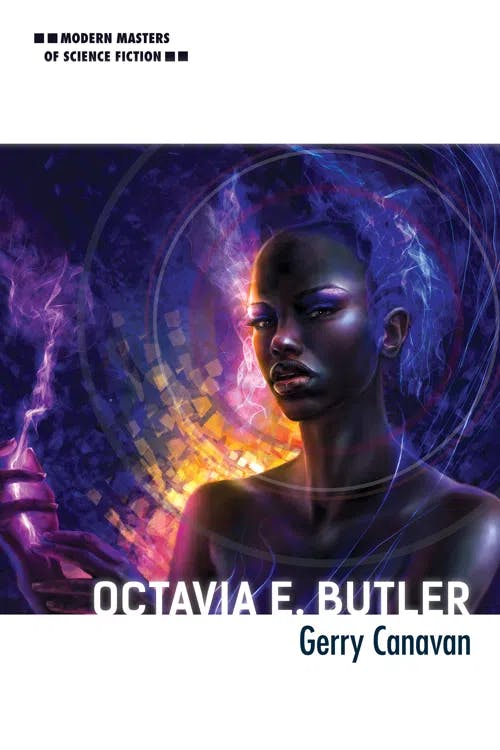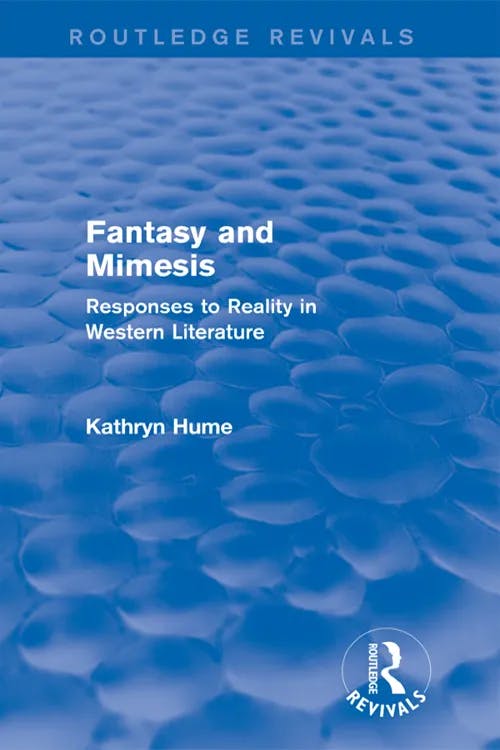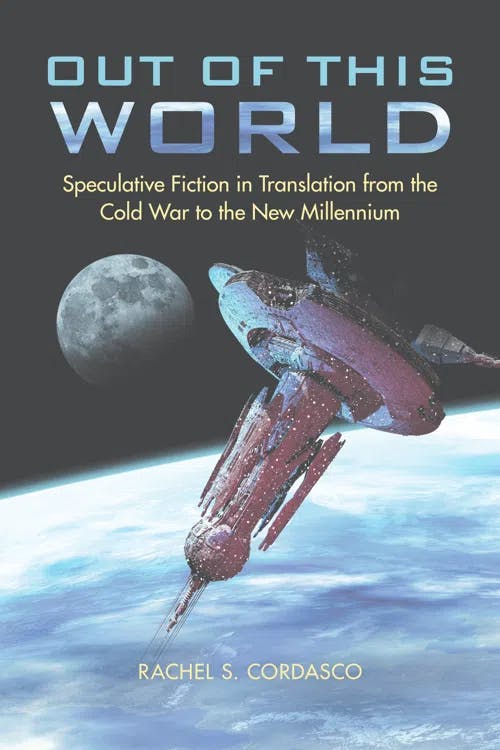What is Speculative Fiction?
MA, English Literature (University College London)
Date Published: 03.08.2023,
Last Updated: 21.02.2024
Share this article
Defining speculative fiction
The poet’s eye, in a fine frenzy rolling,
Doth glance from heaven to earth, from earth to heaven;
And as imagination bodies forth
The forms of things unknown, the poet’s pen
Turns them to shapes, and gives to airy nothing
A local habitation and a name.
(1600, [2017])
William Shakespeare
The poet’s eye, in a fine frenzy rolling,
Doth glance from heaven to earth, from earth to heaven;
And as imagination bodies forth
The forms of things unknown, the poet’s pen
Turns them to shapes, and gives to airy nothing
A local habitation and a name.
(1600, [2017])
When Shakespeare extols the virtues of the creative imagination here, he is also celebrating speculative fiction — as they are closely related. The history of speculative fiction, in fact, is as long as the history of the human imagination itself. From traditional folk tales to Star Wars, and ancient myths to J.R.R. Tolkien’s The Lord of the Rings (1954-55), we have long been entranced by visions of the extraordinary. Speculative fiction refers to fiction which looks beyond our own reality to speculate on different worlds — sometimes a new vision of our own world, and sometimes an entirely new world and mode of being altogether. These different worlds can take many forms, and encompass many storytelling traditions. The central question that animates these speculative visions is “what if?” What if dragons and magic existed? What if time travel was possible? What if we lived forever? What if history happened differently? What if we lived in a totalitarian society? What if there was a nuclear apocalypse?
As a dedicated term, speculative fiction emerged in the mid-twentieth century, but it has not always had the same meaning. As Marek Oziewicz explains,
The term “speculative fiction” has three historically located meanings: a subgenre of science fiction that deals with human rather than technological problems, a genre distinct from and opposite to science fiction in its exclusive focus on possible futures, and a super category for all genres that deliberately depart from imitating “consensus reality” of everyday experience. (“Speculative fiction,” Oxford Research Encyclopedias, 2017)
With the historical prejudice against science fiction (with many critics considering it a less worthy genre), some writers were attracted to the “possible futures” definition of speculative fiction due to its clear distinction from science fiction. (Other science fiction writers may object, of course, that some of the more “out-there” science fiction ideas are also a perfectly possible future.) Margaret Atwood is one contemporary writer who favors this more restrictive definition of speculative fiction for her own work, such as The Handmaid’s Tale (1985):
The Handmaid’s Tale is speculative fiction in the genre of Brave New World and Nineteen Eighty-Four. Nineteen Eighty-Four was written not as science fiction but as an extrapolation of life in 1948. So, too, The Handmaid’s Tale is a slight twist on the society we have now. (Atwood, quoted by Gina Wisker in Margaret Atwood: An Introduction to Critical Views of Her Fiction, 2011)
Gina Wisker
The Handmaid’s Tale is speculative fiction in the genre of Brave New World and Nineteen Eighty-Four. Nineteen Eighty-Four was written not as science fiction but as an extrapolation of life in 1948. So, too, The Handmaid’s Tale is a slight twist on the society we have now. (Atwood, quoted by Gina Wisker in Margaret Atwood: An Introduction to Critical Views of Her Fiction, 2011)
This version of speculative fiction is moored in our present understanding of reality; concerned with building future visions by rearranging the blocks of our own world. There is a lot of crossover with dystopian fiction here — The Handmaid’s Tale, for example, portrays an ultra-patriarchal, totalitarian future.
With such alternative conceptions in mind, however, speculative fiction has now come to be understood as the “super category” which Oziewicz outlines here:
speculative fiction in its most recent understanding is a fuzzy set super category that houses all non-mimetic genres—genres that in one way or another depart from imitating consensus reality—from fantasy, science fiction, and horror to their derivatives, hybrids, and cognate genres, including the gothic, dystopia, zombie, vampire and post-apocalyptic fiction, ghost stories, weird fiction, superhero tales, alternate history, steampunk, slipstream, magic realism, retold or fractured fairy tales, and many more. (2017)
Speculative fiction is now an extremely broad label, then. In essence, it can be applied to any form of fiction which departs, in any way, from the accepted rules of our own world. Many writers and creators identify their work as an example of speculative fiction precisely because of its broad definition, as they resist being pigeonholed into a more restrictive genre. In Gary K. Wolfe’s view,
speculative fiction has been useful precisely because it allows the blurring of boundaries, which in turn permits a greater auctorial freedom from genre constraints and rules. (Wolfe, quoted by Rachael S. Cordasco in Out of This World, 2021)
Rachel S. Cordasco
speculative fiction has been useful precisely because it allows the blurring of boundaries, which in turn permits a greater auctorial freedom from genre constraints and rules. (Wolfe, quoted by Rachael S. Cordasco in Out of This World, 2021)
Although critical appraisal is often focused on literature, speculative fiction also encompasses other modes of storytelling: such as comics/graphic novels, TV, film, theater, and video games. In the following sections, we will delve deeper into the what and why of speculative fiction.
Why speculative fiction?
So why speculate about other worlds, other realities? Why not create stories about our own reality? The question could equally be phrased as: why do we like magic, awe, and wonder?
Speculative fiction has no limits. It is the human imagination unconstrained; free to transport us beyond our everyday lives and reality into other worlds, modes of being, and thought. This speculative imagination also has a real-world impact; allowing us to look at our reality with fresh eyes, and imagine alternatives. Its impact is also important in terms of providing consolation, inspiration, education, entertainment, meaning, and more. Storytelling is central to humanity, and a great appeal of stories is their ability to transport us.
Speculative fiction allows us to expand our imagination into other worlds, both for their own sake and for the new perspectives they may provide of our own world. It is often powerfully employed as a prism through which we can assess the troubling aspects of existing societies: whether it’s with the treatment of the environment, ethnic minorities, women, or LGBTQIA+ people — and more. Just some of the speculative fiction in this vein includes:
- Ursula Le Guin’s The Left Hand of Darkness (1969), which explores the societal effects of sex and gender through an ambisexual alien race.
- Okja (Bong Joon-ho, 2017), which gives us a new perspective on animal rights through the story of a young girl and a genetically modified “super pig.”
- George Orwell’s dystopian 1984 (1949) has become almost synonymous with the concept of a totalitarian surveillance state. V for Vendetta (1982–89), by Alan Moore and David Lloyd, is another influential portrayal of speculative totalitarianism — with its Guy Fawkes mask being adopted as an anti-establishment symbol in a variety of movements.
With its limitless parameters, speculative fiction can be a powerful space for self-expression for both authors and readers alike. Breaking free of prevailing societal norms, speculative fiction frees the imagination and provides room for new (or previously repressed) identities to take wing.
Octavia E. Butler’s highly successful career is an intriguing example of this. As an African-American woman writing in a society (and industry) dominated by white men, Butler found speculative fiction to be an empowering space. As fellow speculative fiction writer Eugen Bacon argues,
Speculative fiction has over decades equipped authors like Octavia Butler with the foundations to cultivate inclusive worlds and characters. In speculative fiction Butler discovered a place and a voice to write ‘herself in’ because novels and short stories of her time in a male-dominated world of genre fiction did not feature an ‘other’ like her. (2019)
Eugen Bacon
Speculative fiction has over decades equipped authors like Octavia Butler with the foundations to cultivate inclusive worlds and characters. In speculative fiction Butler discovered a place and a voice to write ‘herself in’ because novels and short stories of her time in a male-dominated world of genre fiction did not feature an ‘other’ like her. (2019)
Through speculative fiction, writers such as Butler can express the marginalized experience and criticize the social hierarchies of our own world. In Gerry Canavan’s words,
[Butler] proved that the speculations of science fiction could no longer afford to ignore the fraught questions of identity and difference that have transformed global society across all levels in the postwar period. [...] The future never belonged to just one tiny fraction of the human race. (2016)
Gerry Canavan
[Butler] proved that the speculations of science fiction could no longer afford to ignore the fraught questions of identity and difference that have transformed global society across all levels in the postwar period. [...] The future never belonged to just one tiny fraction of the human race. (2016)
Another example of speculative fiction in this mold is found with Malorie Blackman’s Noughts and Crosses series (2001–21), which imagines an alternative history where racial dynamics of oppression are reversed. For more on this topic, you can read our guide on Afrofuturism — a term which describes the speculative reimagining of the past, present, and future through a Black cultural lens.
Although speculative fiction portrays other worlds, then, it can provide new and deeply powerful ways of looking at our own. On fantasy fiction in particular, Ann Swinfen argues that
modern fantasy, far from being the escapist literature which it is sometimes labelled, is a serious form of the modern novel, often characterized by notable literary merit, and concerned both with heightened awareness of the complex nature of primary reality and with the exploration beyond empirical experience into the transcendent reality, embodied in imaginative and spiritual otherworlds. (1984, [2019])
Ann Swinfen
modern fantasy, far from being the escapist literature which it is sometimes labelled, is a serious form of the modern novel, often characterized by notable literary merit, and concerned both with heightened awareness of the complex nature of primary reality and with the exploration beyond empirical experience into the transcendent reality, embodied in imaginative and spiritual otherworlds. (1984, [2019])
Fantasy fiction’s portrayal of other worlds, Swinfen writes, enables a “magical renewing and refreshment of our perceptions” which allows us to “view the primary world, dulled through familiarity, with newly wondering eyes” (1984, [2019]). Because Swinfen is writing in response to critics’ disdain for the fantasy genre, it is understandable that so much weight is given to its real-world impact and value. But many would also argue that such a dichotomy (between “escapist literature” and “literary merit”) does not actually have to be made — that speculative fiction’s ability to transport us to other worlds is valuable in and of itself, without the need to constantly refer back to our own world.
Oziewicz argues, for example, that “speculative fiction emerges as a tool to dismantle the traditional Western cultural bias in favor of literature imitating reality, and as a quest for the recovery of the sense of awe and wonder” (2017). Speculative fiction’s ability to inspire such “awe and wonder” is one of its most valuable qualities, and key to its enduring appeal.
Unpacking speculative fiction
Here we will explore some of the main genres and subgenres that are contained within the wider super genre of speculative fiction. As we will see, there are many debates around where (if at all) the line can be drawn between these genres, as there is a lot of crossover between them.
Fantasy and science fiction are the leading genres within speculative fiction, and many of the other subgenres we touch upon (such as alternate history) have been variously assigned to one, the other, or both at once. Others argue that these subgenres should be kept clearly distinct from the two titans of fantasy and science fiction (along with all the associations they have gathered over time), in order to provide the reader with a clearer idea of what to expect. One thing is clear, however: they are all examples of speculative fiction.
Fantasy fiction
Fantasy is arguably the most free-form genre within speculative fiction, as by definition it transgresses rules and expectations. In Fantasy and Mimesis (2014), Kathryn Hume provides the following definition:
Fantasy is any departure from consensus reality, an impulse native to literature and manifested in innumerable variations, from monster to metaphor. It includes transgressions of what one generally takes to be physical facts [...].
Kathryn Hume
Fantasy is any departure from consensus reality, an impulse native to literature and manifested in innumerable variations, from monster to metaphor. It includes transgressions of what one generally takes to be physical facts [...].
Due to its “fantastical” nature, fantasy can be a difficult genre to categorically pin down — the only limit is the human imagination. In Swinfen’s view,
The essential ingredient of all fantasy is ‘the marvellous’, which will be regarded as anything outside the normal space-time continuum of the everyday world. [...] The marvellous element which lies at the heart of all fantasy is composed of what can never exist in the world of empirical experience. (1984, [2019])
As we have touched upon in the general discussion of speculative fiction above, fantasy fiction can technically be traced back to the very first stories created by humans. Human history is full of fantastical folklore, and fantasy fiction therefore belongs to a rich tradition. Although the Western literary canon is often hermetically sealed away from the fantasy genre, just a few of its many fantastical works include Homer’s The Odyssey (c. 8th century BCE), Beowulf (c. 700–1000), Dante’s The Divine Comedy (c. 1321), and Shakespeare’s A Midsummer Night’s Dream (1600).
When it comes to discussing modern fantasy fiction, it is impossible not to mention the looming presence of J.R.R. Tolkien, who still seems to keep a watchful eye over the landscape like a benevolent version of his Eye of Sauron. Along with Tolkien’s other work, The Lord of the Rings (1954-55) has had a huge influence on modern fantasy fiction — particularly the “high” (or “medieval”) fantasy subgenre, which is often concerned with an epic battle between good and evil. Tolkien created a rich, detailed mythology, supported by astonishing levels of worldbuilding.
Medieval-inspired fantasy in the mold of The Lord of the Rings remains a key strand of fantasy fiction, with authors such as George R. R. Martin and Robin Hobb finding widespread success. Tolkien-inspired fantasy has become a tradition of its own, spawning a huge number of successful works across a range of mediums — with The Elder Scrolls V: Skyrim (2011) being just one example from the world of video games. But the genre of fantasy fiction is not limited to this “high” or “medieval” fantasy subgenre. Just some of the other subgenres within fantasy fiction include:
- Low fantasy and urban fantasy, where fantastical elements are present in a normal world. Buffy the Vampire Slayer (Whedon, 1997–2003) and Neil Gaiman’s Neverwhere (1996) are just two examples.
- Historical fantasy, where fantastical elements are incorporated into a setting which resembles real-world history. Notable examples include Susanna Clarke’s Jonathan Strange and Mr Norrell (2004) and Erin Morgenstern’s The Night Circus (2011).
- Science fantasy, which incorporates elements of both science fiction and fantasy. Star Wars is often placed in this category, due to its fantastical elements.
As we’ve already mentioned, though, there are no truly clear-cut distinctions between the various genres of speculative fiction. In Out of This World, for example, Rachael S. Cordasco writes that fantasy can also “act as a vast umbrella term” for other subgenres such as “gothic fantasy, surrealism, magical realism, and the Weird” (2021). For more information, you can explore our dedicated study guides on these topics here:
- Gothic Fiction - Key Elements of Gothic Literature & Film
- Surrealism in Literature & Film: An Introduction
- What is Magical Realism?
- What is Weird Fiction?
Science fiction
Alongside fantasy, science fiction is undoubtedly the most influential genre of speculative fiction. Science fiction is usually understood as what could happen within certain scientific parameters — even if the parameters which govern our present understanding of the world are very different. If speculative fiction as a whole asks “what if?”, then fantasy asks “what if the impossible were true?” and science fiction asks “what if the possible were true?” Although science fiction usually portrays a new set of circumstances, which may differ from our present understanding of reality, these are generally (in theory) explainable in a material sense. While a dragon may be a magical creature in fantasy, science fiction may portray it as an extraterrestrial life form instead. The line between advanced science and magic is often blurred, however, with some of the more fantastical science fiction stories often grouped under “science fantasy” accordingly. As always, caveats apply: definitive genre definitions are often criticized, along with the concept of “genre” itself.
If we hope to cautiously identify science fiction in general, then, Cordasco explains:
Science fiction includes texts whose stories are based on agreed-upon scientific or historical premises and involve what Darko Suvin has called the “interaction of estrangement and cognition” in the face of a “novum” (new physical law, idea, and so forth). (2021)
Rachel S. Cordasco
Science fiction includes texts whose stories are based on agreed-upon scientific or historical premises and involve what Darko Suvin has called the “interaction of estrangement and cognition” in the face of a “novum” (new physical law, idea, and so forth). (2021)
Popular examples of such “novums” include space travel, time travel, and other new technologies, as well as extraterrestrial life and planets.
When we come to assessing the origins of science fiction, there is much debate. Adam Roberts traces the beginnings of science fiction to the beginnings of science itself, and highlights the significance of the Copernican revolution in the 17th century, where new ideas of Earth’s place in the cosmos initiated science fiction anxieties and fantasies:
These issues—the anxieties generated by Copernicus’s undermining of our special place in the universe; questions of transcendence and atonement; and a sense of the purposiveness and profusion of cosmic life—still haunt sf. (Roberts, “The Copernican Revolution,” in The Routledge Companion to Science Fiction, 2009)
Edited by Mark Bould, Andrew M. Butler, Adam Roberts, and Sherryl Vint
These issues—the anxieties generated by Copernicus’s undermining of our special place in the universe; questions of transcendence and atonement; and a sense of the purposiveness and profusion of cosmic life—still haunt sf. (Roberts, “The Copernican Revolution,” in The Routledge Companion to Science Fiction, 2009)
Mary Shelley’s Frankenstein (1818) is often identified as the first science fiction novel, but Roberts points out that this chronology
leaves commentators with the problem of accounting for a large body of work of much greater antiquity that contains many of the features and tropes we all recognize as sf: travel to other planets, encounters with extraterrestrial lifeforms, utopian social speculation, and futuristic extrapolation. (2009)
Some of these earlier examples include “The solidly science-based imaginative extrapolation of Johannes Kepler’s A Dream, or Lunar Astronomy (1634; written c. 1600),” which stands as “the first genuine attempt at imagining alien life in terms of radical otherness” (Roberts, 2009).
Science fiction is often separated into “hard” and “soft” variants (although the value and accuracy of such a distinction is disputed). Hard science fiction is understood as
[science fiction] that draws explicitly and extensively on the language of science, that embeds its plots and innovations within contemporary scientific knowledge (and extrapolates beyond), and that organizes its narrative around such scientific data [...]. (2014)
Sherryl Vint
[science fiction] that draws explicitly and extensively on the language of science, that embeds its plots and innovations within contemporary scientific knowledge (and extrapolates beyond), and that organizes its narrative around such scientific data [...]. (2014)
Soft science fiction, on the other hand, is “more concerned with people and relationships than science, and may bear philosophical, alternate history or social science themes” (Bacon, 2019). To take one example, Arrival (Villeneuve, 2016) exhibits many soft science fiction characteristics, but its focus on the linguistic aspects of alien contact arguably edges it into the hard science fiction category. On the other hand, Flowers for Algernon (Daniel Keyes, 1966) explores the social, psychological, and emotional effects of a scientific experiment which increases the intelligence of an intellectually disabled man. Due to its emphasis on these aspects, rather than the technical aspects of the experiment involved, Flowers for Algernon may be identified as soft science fiction. In both examples, we can see that elements of both hard and soft science fiction are present — illustrating the difficulties of these concepts.
The sense of awe and wonder we have already mentioned is particularly key to the appeal of science fiction, with such popular creations as Frank Herbert’s Dune (1965) and Isaac Asimov’s Foundation (1951) thrilling us with expansive visions of the universe. In a crowded field, Olaf Stapledon’s Star Maker (1937) is one of the most awe-inspiring science fiction visions of all. Star Maker answers the speculative question: what if we could travel across the entire universe, and peer into the mysteries behind its nature and creation? In many ways, Star Maker is the ultimate example of speculative fiction; as it speculates about the fundamental questions which underpin all others: what is reality all about, what is our purpose, does the universe have a maker — and do they care about us?
There are many subgenres of science fiction, such as space opera, military science fiction, and cyberpunk. As with fantasy fiction, other subgenres within speculative fiction are often placed beneath the banner of science fiction. Notable examples include:
- Utopian and dystopian fiction, which depict speculative societies which are either better (utopia) or worse (dystopia) than reality.
- Alternate history, where a “what-if analogy [...] shifts a historical event to produce alternate futuristic outcomes” (Bacon, 2019). Philip K. Dick’s The Man in the High Castle (1962) is a well-known example; depicting an alternative history in which the Allies have lost the Second World War and the United States has been partitioned by the triumphant Axis powers.
For more on science fiction, The Routledge Companion to Science Fiction (2009) provides comprehensive and insightful commentary.
Other subgenres
Although fantasy and science fiction are the two primary modes of speculative fiction, it is a vast field with much more to offer. Many of the following genres and/or subgenres have already been mentioned above, due to their debated allegiance to fantasy and science fiction, but it may be useful to have them all in one place here:
- Utopian and dystopian fiction
- Horror, supernatural fiction, and the Gothic
- Weird fiction
- Magical realism
- Surrealism
- Steampunk
- Cyberpunk
- Superhero fiction
- Alternate history
For more information, Eugen Bacon provides a detailed commentary on speculative fiction’s subgenres in Writing Speculative Fiction (2019).
Closing thoughts
Speculative fiction continues to be an influential cultural force, with a glance at the genres of the highest-grossing blockbuster films providing just one indication of its popular appeal. Millions of fans obsess over speculative worlds, and find meaning and camaraderie within their liberating spaces. From House of the Dragon (Martin and Condal, 2022) to Cyberpunk 2077 (2020), and Blade Runner 2049 (Villeneuve, 2017) to Piranesi (Susanna Clarke, 2020), speculative fiction continues to find success across a range of cultural mediums. Although its constituent genres have faced critical prejudice in the past, speculative fiction is now prized as a valuable space in which the human imagination is free to interrogate different possibilities and modes of being — all while providing us with visions of awe and wonder which are truly sublime.
Further reading on Perlego
- So Long Been Dreaming: Postcolonial Science Fiction & Fantasy (2004), edited by Nalo Hopkinson and Uppinder Mehan
- Histories of the Future (2016), edited by Alan Sandison and Robert Dingley
- Race and Popular Fantasy Literature (2015) by Helen Young
- Fantasy and Myth in the Anthropocene (2022), edited by Marek Oziewicz, Brian Attebery and Tereza Dědinová
- Once and Future Antiquities in Science Fiction and Fantasy (2018), edited by Brett M. Rogers and Benjamin Eldon Stevens
- Old Futures: Speculative Fiction and Queer Possibility (2018) by Alexis Lothian
- The History of Science Fiction (2016) by Adam Roberts
What is speculative fiction in simple terms?
Which genres are included in speculative fiction?
What is an example of speculative fiction?
What is the difference between speculative fiction, fantasy, and science fiction?
What are the best books on speculative fiction?
Bibliography
Asimov, I. (2021) Foundation. Harper Voyager.
Atwood, M. (2010) The Handmaid’s Tale. Vintage Classics.
Bacon, E. (2019) Writing Speculative Fiction. Bloomsbury Publishing. Available at: https://www.perlego.com/book/2997635/writing-speculative-fiction-creative-and-critical-approaches-pdf
Blackman, M. (2008) Noughts and Crosses. RHCP Digital.
Bould, M. et al. (eds.) (2009) The Routledge Companion to Science Fiction. Taylor and Francis. Available at: https://www.perlego.com/book/1609365/the-routledge-companion-to-science-fiction-pdf
Cadden, M. (2005) Ursula K. Le Guin Beyond Genre. Taylor and Francis. Available at: https://www.perlego.com/book/1698456/ursula-k-le-guin-beyond-genre-fiction-for-children-and-adults-pdf
Canavan, G. (2016) Octavia E. Butler. University of Illinois Press. Available at: https://www.perlego.com/book/2383093/octavia-e-butler-pdf
Clarke, S. (2004) Jonathan Strange and Mr Norrell. Bloomsbury Publishing.
Clarke, S. (2020) Piranesi. Bloomsbury Publishing.
Cordasco, R. (2021) Out of This World. University of Illinois Press. Available at: https://www.perlego.com/book/3059429/out-of-this-world-speculative-fiction-in-translation-from-the-cold-war-to-the-new-millennium-pdf
Dante (2020) The Divine Comedy. Open Road Media. Available at: https://www.perlego.com/book/2448621/the-divine-comedy-inferno-purgatory-and-paradise-pdf
Dick, P. K. (2001) The Man in the High Castle. Penguin Modern Classics.
Gaiman, N. (2021) Neverwhere. Headline Review.
Herbert, F. (2015) Dune. Hodderscape.
Homer (2018) The Odyssey. University of California Press. Available at: https://www.perlego.com/book/570480/the-odyssey-pdf
Hume, K. (2014) Fantasy and Mimesis. Taylor and Francis. Available at: https://www.perlego.com/book/1665506/fantasy-and-mimesis-routledge-revivals-responses-to-reality-in-western-literature-pdf
Keyes, D. (2002) Flowers for Algernon. Gollancz.
Kilian, C. and Moreno-Garcia, S. (2019) A Writer’s Guide to Speculative Fiction: Science Fiction and Fantasy. Self-Counsel Press. Available at: https://www.perlego.com/book/1257513/a-writers-guide-to-speculative-fiction-science-fiction-and-fantasy-pdf
Le Guin, U. (2018) The Left Hand of Darkness. Gollancz.
Lesslie Hall, J. (trans.) (2013) Beowulf. HarperCollins Publishers. Available at: https://www.perlego.com/book/671034/beowulf-pdf
Moore, A. and Lloyd, D. (2020) V for Vendetta. DC Comics.
Morgenstern, E. The Night Circus (2011). Penguin Random House.
Orwell, G. (2021) 1984. GroMedia. Available at: https://www.perlego.com/book/2663769/1984-pdf
Otto, R. (2021) The Idea of the Holy. Wipf and Stock Publishers. Available at: https://www.perlego.com/book/2707790/the-idea-of-the-holy-an-inquiry-into-the-nonrational-factor-in-the-idea-of-the-divine-and-its-relation-to-the-rational-pdf
Oziewicz, M. (2017) “Speculative fiction,” Oxford Research Encyclopedias. Oxford University Press. Available at: https://oxfordre.com/literature/display/10.1093/acrefore/9780190201098.001.0001/acrefore-9780190201098-e-78
Roberts, A. (2006) Science Fiction. 2nd edn. Taylor and Francis. Available at: https://www.perlego.com/book/1624414/science-fiction-pdf
Shakespeare, W. (2017) A Midsummer Night’s Dream. Bloomsbury Publishing. Available at: https://www.perlego.com/book/394902/a-midsummer-nights-dream-third-series-pdf
Shelley, M. (2012) Frankenstein. 3rd edn. Broadview Press. Available at: https://www.perlego.com/book/2029915/frankenstein-third-edition-pdf
Stapledon, O. and Nemo, A. (ed.) (2022) Essential Novelists - Olaf Stapledon. Tacet Books. Available at: https://www.perlego.com/book/3180058/essential-novelists-olaf-stapledon-pdf
Swinfen, A. (2019) In Defence of Fantasy. Taylor and Francis. Available at: https://www.perlego.com/book/1476689/in-defence-of-fantasy-a-study-of-the-genre-in-english-and-american-literature-since-1945-pdf
Tolkien, J.R.R., (2021) The Lord of the Rings. HarperCollins.
Vint, S. (2014) Science Fiction: A Guide for the Perplexed. Bloomsbury Publishing. Available at: https://www.perlego.com/book/874961/science-fiction-a-guide-for-the-perplexed-pdf
Wisker, G. (2011) Margaret Atwood: An Introduction to Critical Views of Her Fiction. Bloomsbury Publishing. Available at: https://www.perlego.com/book/2990558/margaret-atwood-an-introduction-to-critical-views-of-her-fiction-pdf
Filmography
Arrival (2016) Directed by Denis Villeneuve [Blu-ray]. Universal Pictures UK.
Blade Runner 2049 (2017) Directed by Denis Villeneuve [Blu-ray]. Sony Pictures.
House of the Dragon (2022) Created by George R.R. Martin and Ryan J. Condal [Blu-ray]. Warner Bros.
Okja (2017) Directed by Bong Joon-ho. Available on Netflix.
MA, English Literature (University College London)
Andy Cain has an MA in English Literature from University College London, and a BA in English and Creative Writing from Royal Holloway, University of London. His particular research interests include science fiction, fantasy, and the philosophy of art. For his MA dissertation, he explored the presence of the sublime in Shakespeare’s plays.


